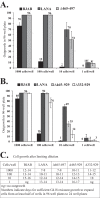Identification of Kaposi's sarcoma-associated herpesvirus LANA regions important for episome segregation, replication, and persistence
- PMID: 24006437
- PMCID: PMC3807934
- DOI: 10.1128/JVI.01243-13
Identification of Kaposi's sarcoma-associated herpesvirus LANA regions important for episome segregation, replication, and persistence
Abstract
Kaposi's sarcoma-associated herpesvirus (KSHV) latency-associated nuclear antigen (LANA) is a 1,162-amino-acid protein that mediates the maintenance of episomal viral genomes in latently infected cells. The two central components of episome persistence are DNA replication with each cell division and the segregation of DNA to progeny nuclei. LANA self-associates to bind KSHV terminal-repeat (TR) DNA and to mediate its replication. LANA also simultaneously binds to TR DNA and mitotic chromosomes to mediate the segregation of episomes to daughter nuclei. The N-terminal region of LANA binds histones H2A and H2B to attach to mitotic chromosomes, while the C-terminal region binds TR DNA and also associates with chromosomes. Both the N- and C-terminal regions of LANA are essential for episome persistence. We recently showed that deletion of all internal LANA sequences results in highly deficient episome maintenance. Here we assess independent internal LANA regions for effects on episome persistence. We generated a panel of LANA mutants that included deletions in the large internal repeat region and in the unique internal sequence. All mutants contained the essential N- and C-terminal regions, and as expected, all maintained the ability to associate with mitotic chromosomes in a wild-type fashion and to bind TR DNA, as assessed by electrophoretic mobility shift assays (EMSA). Deletion of the internal regions did not reduce the half-life of LANA. Notably, deletions within either the repeat elements or the unique sequence resulted in deficiencies in DNA replication. However, only the unique internal sequence exerted effects on the ability of LANA to retain green fluorescent protein (GFP) expression from TR-containing episomes deficient in DNA replication, consistent with a role in episome segregation; this region did not independently associate with mitotic chromosomes. All mutants were deficient in episome persistence, and the deficiencies ranged from minor to severe. Mutants deficient in DNA replication that contained deletions within the unique internal sequence had the most-severe deficits. These data suggest that internal LANA regions exert critical roles in LANA-mediated DNA replication, segregation, and episome persistence, likely through interactions with key host cell factors.
Figures








Similar articles
-
Kaposi's Sarcoma-Associated Herpesvirus LANA-Adjacent Regions with Distinct Functions in Episome Segregation or Maintenance.J Virol. 2019 Mar 5;93(6):e02158-18. doi: 10.1128/JVI.02158-18. Print 2019 Mar 15. J Virol. 2019. PMID: 30626680 Free PMC article.
-
The internal Kaposi's sarcoma-associated herpesvirus LANA regions exert a critical role on episome persistence.J Virol. 2011 Aug;85(15):7622-33. doi: 10.1128/JVI.00304-11. Epub 2011 May 18. J Virol. 2011. PMID: 21593163 Free PMC article.
-
The Kaposi Sarcoma Herpesvirus Latency-associated Nuclear Antigen DNA Binding Domain Dorsal Positive Electrostatic Patch Facilitates DNA Replication and Episome Persistence.J Biol Chem. 2015 Nov 20;290(47):28084-28096. doi: 10.1074/jbc.M115.674622. Epub 2015 Sep 29. J Biol Chem. 2015. PMID: 26420481 Free PMC article.
-
The latency-associated nuclear antigen, a multifunctional protein central to Kaposi's sarcoma-associated herpesvirus latency.Future Microbiol. 2011 Dec;6(12):1399-413. doi: 10.2217/fmb.11.137. Future Microbiol. 2011. PMID: 22122438 Free PMC article. Review.
-
Kaposi's Sarcoma Herpesvirus Genome Persistence.Front Microbiol. 2016 Aug 12;7:1149. doi: 10.3389/fmicb.2016.01149. eCollection 2016. Front Microbiol. 2016. PMID: 27570517 Free PMC article. Review.
Cited by
-
Identification of Novel Kaposi's Sarcoma-Associated Herpesvirus Orf50 Transcripts: Discovery of New RTA Isoforms with Variable Transactivation Potential.J Virol. 2016 Dec 16;91(1):e01434-16. doi: 10.1128/JVI.01434-16. Print 2017 Jan 1. J Virol. 2016. PMID: 27795414 Free PMC article.
-
A short sequence immediately upstream of the internal repeat elements is critical for KSHV LANA mediated DNA replication and impacts episome persistence.Virology. 2014 Jan 5;448:344-55. doi: 10.1016/j.virol.2013.10.026. Epub 2013 Nov 12. Virology. 2014. PMID: 24314665 Free PMC article.
-
LANA-dependent transcription-replication conflicts and R-loops at the terminal repeats (TR) correlate with KSHV episome maintenance.PLoS Pathog. 2025 Aug 18;21(8):e1013029. doi: 10.1371/journal.ppat.1013029. eCollection 2025 Aug. PLoS Pathog. 2025. PMID: 40825050 Free PMC article.
-
LANA oligomeric architecture is essential for KSHV nuclear body formation and viral genome maintenance during latency.PLoS Pathog. 2019 Jan 25;15(1):e1007489. doi: 10.1371/journal.ppat.1007489. eCollection 2019 Jan. PLoS Pathog. 2019. PMID: 30682185 Free PMC article.
-
Heterogeneous Activation of Signaling Pathways and Therapeutic Vulnerabilities in KSHV-Associated Primary Effusion Lymphoma Cell Lines.J Med Virol. 2025 Aug;97(8):e70534. doi: 10.1002/jmv.70534. J Med Virol. 2025. PMID: 40751690 Free PMC article.
References
-
- Cesarman E, Moore PS, Rao PH, Inghirami G, Knowles DM, Chang Y. 1995. In vitro establishment and characterization of two acquired immunodeficiency syndrome-related lymphoma cell lines (BC-1 and BC-2) containing Kaposi's sarcoma-associated herpesvirus-like (KSHV) DNA sequences. Blood 86:2708–2714 - PubMed
-
- Chang Y, Cesarman E, Pessin MS, Lee F, Culpepper J, Knowles DM, Moore PS. 1994. Identification of herpesvirus-like DNA sequences in AIDS-associated Kaposi's sarcoma. Science 266:1865–1869 - PubMed
-
- Moore PS, Chang Y. 1995. Detection of herpesvirus-like DNA sequences in Kaposi's sarcoma in patients with and without HIV infection. N. Engl. J. Med. 332:1181–1185 - PubMed
-
- Soulier J, Grollet L, Oksenhendler E, Cacoub P, Cazals-Hatem D, Babinet P, d'Agay MF, Clauvel JP, Raphael M, Degos L, Sigaux F. 1995. Kaposi's sarcoma-associated herpesvirus-like DNA sequences in multicentric Castleman's disease. Blood 86:1276–1280 - PubMed
-
- Decker LL, Shankar P, Khan G, Freeman RB, Dezube BJ, Lieberman J, Thorley-Lawson DA. 1996. The Kaposi sarcoma-associated herpesvirus (KSHV) is present as an intact latent genome in KS tissue but replicates in the peripheral blood mononuclear cells of KS patients. J. Exp. Med. 184:283–288 - PMC - PubMed
Publication types
MeSH terms
Substances
Grants and funding
LinkOut - more resources
Full Text Sources
Other Literature Sources

